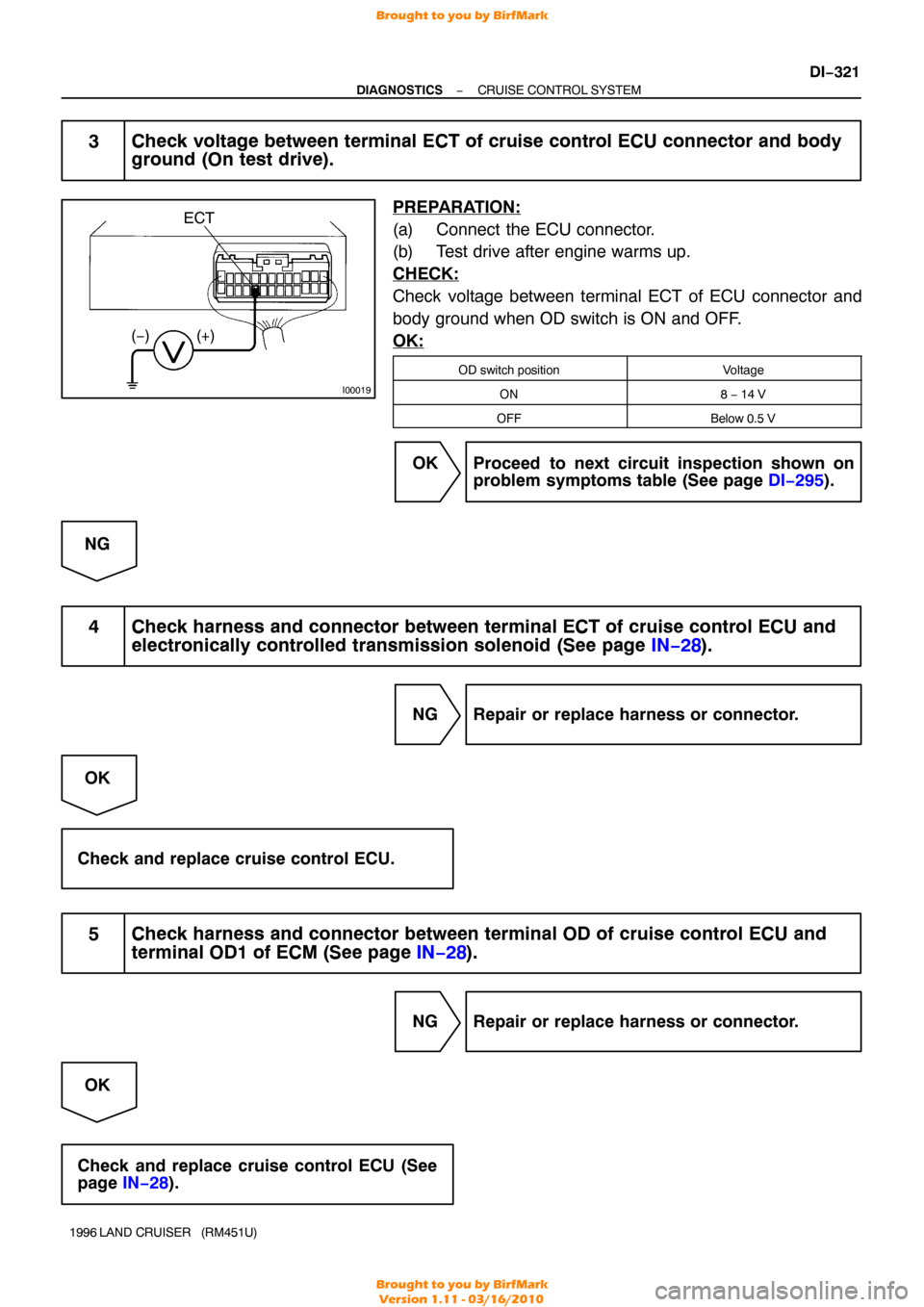Page 754 of 1399
AB0119I00012 I00025
ON
OD
(−) (+)
DI−320
−
DIAGNOSTICS CRUISE CONTROL SYSTEM
1996 LAND CRUISER (RM451U)
INSPECTION PROCEDURE
1 Check operation of overdrive.
PREPARATION:
Test drive after engine warms up.
CHECK:
Check that overdrive ON ↔ OFF occurs with operation of OD switch ON−OFF.
NG Check and repair electronically controlledtransmission (See page DI−129 ).
OK
2 Check voltage between terminal OD of harness side connector of cruise co\
ntrol ECU and body ground.
PREPARATION:
(a) Remove the ECU with connector still connected.
(b) Turn ignition switch ON.
(c) Disconnect the ECU connector.
CHECK:
Measure voltage between terminal OD of harness side connec-
tor of ECU and body ground.
OK:
Voltage: 10 − 14 V
NG Go to step 5.
OK
Brought to you by BirfMark
Brought to you by BirfMark
Version 1.11 - 03/16/2010
Page 755 of 1399

I00019
ECT
(−) (+)
−
DIAGNOSTICS CRUISE CONTROL SYSTEM
DI−321
1996 LAND CRUISER (RM451U)
3 Check voltage between terminal ECT of cruise control ECU connector and body
ground (On test drive).
PREPARATION:
(a) Connect the ECU connector.
(b) Test drive after engine warms up.
CHECK:
Check voltage between terminal ECT of ECU connector and
body ground when OD switch is ON and OFF.
OK:
OD switch positionVoltage
ON8 − 14 V
OFFBelow 0.5 V
OK Proceed to next circuit inspection shown on
problem symptoms table (See page DI−295 ).
NG
4 Check harness and connector between terminal ECT of cruise control ECU a\
nd electronically controlled transmission solenoid (See page IN−28).
NG Repair or replace harness or connector.
OK
Check and replace cruise control ECU.
5 Check harness and connector between terminal OD of cruise control ECU an\
d terminal OD1 of ECM (See page IN−28 ).
NG Repair or replace harness or connector.
OK
Check and replace cruise control ECU (See
page IN−28 ).
Brought to you by BirfMark
Brought to you by BirfMark
Version 1.11 - 03/16/2010
Page 757 of 1399
Input SignalIndicator Light
Blinking Pattern
Turn PNP switch
OFF (Shift to
except D position)
LightON
OFF SW ON
SW OFF
−
DIAGNOSTICS CRUISE CONTROL SYSTEM
DI−323
1996 LAND CRUISER (RM451U)
INSPECTION PROCEDURE
1 Check starter operation.
CHECK:
Check that the starter operates normally and that the engine starts.
NG Proceed to engine troubleshooting (See page DI−1).
OK
2 Input signal check.
PREPARATION:
See input signal check on page DI−286.
CHECK:
Check the indicator light when shifting into except D position.
OK:
The indicator light goes off when shifting into except
D position.
OK Proceed to next circuit inspection shown on problem symptoms table (See page DI−295 ).
NG
Brought to you by BirfMark
Brought to you by BirfMark
Version 1.11 - 03/16/2010
Page 771 of 1399

EC07H−06
−
EMISSION CONTROL EMISSION CONTROL SYSTEM
EC−1
614
Author�: Date�:
1996 LAND CRUISER (RM451U)
EMISSION CONTROL SYSTEM
PURPOSE
The emission control systems are installed to reduce the amount of HC, CO a\
nd NOx exhausted from the
engine ((3), (4) and (5)), to prevent the atmospheric release of blow −by gas− containing HC (1) and evapo-
rated fuel containing HC being released from the fuel tank (2).
The function of each system is shown in the following table.
SystemAbbreviationFunction
(1) Positive Crankcase V entilation
(2) Evaporative Emission Control
(3) Exhaust Gas Recirculation
(4) Three− Way Catalytic Converter
(5) Sequential Multiport Fuel Injection*PCV
EVAP EGR
TWC SFIReduces HC
Reduces evaporated HC
Reduces NOx
Reduces HC, CO and NOx
Injects a precisely timed, optimum amount of fuel for reduced
exhaust emissions
Remark: * For inspection and repair of the SFI system, refer to the SF section \
in this manual.
Brought to you by BirfMark
Brought to you by BirfMark
Version 1.11 - 03/16/2010
Page 776 of 1399

EC0GB−01
EC3069
Gasket
Check Valve (V acuum Valve)
EC−6
−
EMISSION CONTROL EVAPORATIVE EMISSION (EVAP) CONTROL SYSTEM
1996 LAND CRUISER (RM451U)
INSPECTION
1. VISUALLY INSPECT LINES AND CONNECTIONS
Look for loose connections, sharp bends or damage.
2. VISUALLY INSPECT FUEL TANK
Look for deformation, cracks or fuel leakage.
3. VISUALLY INSPECT FUEL TANK CAP
Check if the cap and/or gasket are deformed or damaged.
If necessary, repair or replace the cap.
4. INSPECT TVV OPERATION WITH COLD ENGINE
(a) The engine coolant temperature should be below 45 °C
(113 °F).
(b) Disconnect the EVAP hose from the union pipe.
(c) Start the engine.
(d) Gradually increase the engine speed from idle to 3,000 rpm and check that air suction is not felt at the union pipe.
5. INSPECT OPERATION OF VCV WITH HOT ENGINE
(a) Warm up the engine.
(b) With the engine idling, check that air suction is not felt at union pipe.
(c) Gradually increase the engine speed to 3,000 rpm and check that there is air suction at the union pipe.
(d) Reconnect the EVAP hose to the union pipe.
If no problem is found with this inspection, system is normal;
otherwise inspect each part.
6. REMOVE CHARCOAL CANISTER WITH BRACKET
7. REMOVE CHARCOAL CANISTER FROM BRACKET
8. REMOVE CAP FROM CHARCOAL CANISTER
Brought to you by BirfMark
Brought to you by BirfMark
Version 1.11 - 03/16/2010
Page 777 of 1399

−
EMISSION CONTROL EVAPORATIVE EMISSION (EVAP) CONTROL SYSTEM
EC−7
1996 LAND CRUISER (RM451U)
9. VISUALLY INSPECT CHARCOAL CANISTER
Look for cracks or damage.
10. INSPECT FOR CLOGGED FILTER AND STUCK VALVE
(a) Using low pressure compressed air (7.26 kPa, 74 gf/cm
2,
1.05 psi), blow into tank pipe and check that air flows with-
out resistance from the other pipes.
(b) While holding drain pipe closed, blow air (1.96 kPa, 20 gf/
cm
2, 0.28 psi) into purge pipe and check that air flow with-
out resistance from tank pipe.
If a problem is found, replace the charcoal canister.
11. CLEAN FILTER IN CANISTER
Clean the filter by blowing 294 kPa (3 kgf/cm
2, 43 psi) of com-
pressed air into tank pipe while holding purge pipe closed.
NOTICE:
Do not attempt to wash the canister.No activated carbon
should come out.
12. REINSTALL CAP TO CHARCOAL CANISTER
13. REINSTALL CHARCOAL CANISTER TO BRACKET Torque: 14 N·m (145 kgf·cm, 10 ft·lbf)
14. REINSTALL CHARCOAL CANISTER WITH BRACKET Torque: 18 N·m (185 kgf·cm, 13 ft·lbf)
15. DRAIN ENGINE COOLANT
Brought to you by BirfMark
Brought to you by BirfMark
Version 1.11 - 03/16/2010
Page 778 of 1399
EC−8
−
EMISSION CONTROL EVAPORATIVE EMISSION (EVAP) CONTROL SYSTEM
1996 LAND CRUISER (RM451U)
16. REMOVE TVV FROM CYLINDER HEAD
(a) Disconnect the 2 vacuum hoses.
(b) Remove the TVV.
17. INSPECT TVV OPERATION
(a) Cool the TVV to below 45° C (113°F) with cool water.
(b) Check that air flows from pipe J to the air filter.
(c) Heat the TVV to above 64° C (147°F) with hot water.
(d) Check that air flows from pipe J to pipe K.
If operation is not as specified, replace the TVV.
18. REINSTALL TVV
(a) Apply adhesive to 2 or 3 threads of the TVV, and install it.
Adhesive:
Part No. 08833 −00070, THREE BOND 1324
or equivalent
Torque: 29 N·m (300 kgf·cm, 22 ft·lbf)
(b) Reconnect 2 vacuum hoses.
19. REFILL WITH ENGINE COOLANT
20. REMOVE INTAKE MANIFOLD STAY
21. REMOVE VCV
Brought to you by BirfMark
Brought to you by BirfMark
Version 1.11 - 03/16/2010
Page 781 of 1399

EC0JT−01
−
EMISSION CONTROL EXHAUST GAS RECIRCULATION (EGR) SYSTEM
EC−11
1996 LAND CRUISER (RM451U)
INSPECTION
1. INSPECT AND CLEAN FILTER IN EGR V ACUUM MOD-
ULATOR
(a) Remove the cap and filter.
(b) Check the filter for contamination or damage.
(c) Using compressed air, clean the filter.
(d) Reinstall the filter and cap.
HINT:
Install the filter with the coarser surface facing the atmospheric
side (outward).
2. INSTALL VACUUM GAUGE
Using a 3 −way connector, connect a vacuum gauge to the hose
between the EGR valve and EGR vacuum modulator.
3. INSPECT SEATING OF EGR VALVE
Start the engine and check that the engine starts and runs at
idle.
4. CONNECT TOYOTA HAND− HELD TESTER OR OBD II
SCAN TOOL (See page EM−10)
5. INSPECT VSV OPERATION WITH COLD ENGINE
(a) The engine coolant temperature should be below 47 °C
(117 °F).
(b) Check that the vacuum gauge indicates zero at 2,500 rpm.
(c) Check that the EGR pipe is not hot.
6. INSPECT OPERATION OF VSV AND EGR VACUUM
MODULATOR WITH HOT ENGINE
(a) Warm up the engine to above 53° C (127°F).
(b) Check that the vacuum gauge indicates low vacuum at 2,500 rpm.
(c) Disconnect the vacuum hose port R of the EGR vacuum modulator and connect port R directly to the air intake
chamber with another hose.
(d) Check that the vacuum gauge indicates high vacuum at 2,500 rpm.
Brought to you by BirfMark
Brought to you by BirfMark
Version 1.11 - 03/16/2010